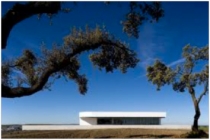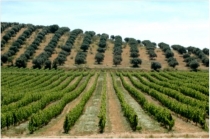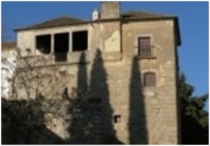Alentejo
Wine region: ALENTEJO
Vine cultivation was already common in pre‑Roman times, and practised by the Tartessians, Phoenicians and Greeks, evidence of whose presence is confirmed by the hundreds of amphorae catalogued at archaeological sites in the Alentejo, in southern Portugal. It was, however, the Romans who exploited the vineyards of the Alentejo on a grand scale, transporting their wines in boats on the Guadiana River. It is here that earthenware vessels of all shapes and sizes were discovered, some of which were capable of holding 2,000 litres of must, weighed close to a tonne and measured almost two metres high. The region was overcome by the eighth‑century Muslim invasion and the subsequent Islamification of the Iberian Peninsula. The different occupying tribes were tolerant to a greater or lesser degree of the local wine‑producing activities. The least tolerant were the Almoravids and Almohads who uprooted vineyards or imposed high taxes on them. Vine cultivation deteriorated progressively and in some cases was abandoned completely.
During the Reconquista vine cultivation recovered and the monks re‑established many vineyards. By the 16th century vineyards flourished as never before in the Alentejo, giving rise to the distinguished and acclaimed wines of Évora, and other locations. The first subsequent crisis was caused by the War of Portuguese Independence. In the mid‑17th century, the wines of the Alentejo had gained much acclaim and prestige in Portugal. During the time of the Methuen Treaty, the area of land under vine cultivation increased to over 100,000 hectares. Because of the peace concluded between France and England, however, and English merchants forgetting about the Methuen Treaty, a new crisis developed. Motivated by his own interests in the Douro, the Marquis of Pombal ordered the uprooting of vineyards in the Alentejo. Attempts were made in the middle of the 19th century to recover these vineyards.
Amongst other measures taken was the founding in 1885 of the first cooperative wine cellar in Portugal in Viana do Alentejo. “The establishment of PROVA (Projecto de Viticultura do Alentejo [Viticulture Project of the Alentejo]) in 1977 formed the technical basis required to implement quality certification in the Alentejo. This initiative was reinforced by the foundation of ATEVA (Associação Técnica dos Viticultores do Alentejo [Technical Association of Viticulturists of the Alentejo]) in 1983, and by the formation of the CVRA (Comissão Vitivinícola Regional Alentejana [Alentejo Regional Vitivinicultural Commission]) in 1989”.
“The most important typographic features of Alentejo landscape are the Portel (421 m), Ossa (649 m) and the São Mamede (1,025 m) mountains. The region’s meridional position and the absence of important relief features are what give the climate its Mediterranean and continental characteristics. Nevertheless, micro‑climates within the region are very distinct from one another. The extremely high insolation has a marked influence on the maturation of the grapes which risk reaching excessively high acid and sugar values. For the most part, the vineyards are found in plutonic rock substratum (granites, tonalites, syenites and nepheline syenites), yet the diversity of pedological spots on which vineyards are established (including schist and clay‑limestone spots) should be emphasised. There are 23,400 hectares under vineyard cultivation, producing an average of around 80,000 hectolitres annually.
The Comissão Vitivinícola Regional Alentejana (The Regional Vitivinicultural Commission of the Alentejo), abbreviated to CVRA, was officially approved as the certification authority mandated to regulate the production, trade and certification of vitivinicultural products entitled to bear the “Alentejo” Designation of Origin (DO) and the geographical indication, “Alentejana”. (Quotations from IVV Yearbook)
Types of vitivinicultural products
Alentejano IG wines or Alentejano regional wines: Red, white, rosé, liqueur, sparkling, aguardente bagaceira (grape marc spirit), aguardente vínica (brandy from wine spirit)
Alentejo DO wines (+ subregions: “Portalegre”, “Borba”, “Redondo”, “Reguengos”, “Vidigueira”, “Évora”, “Granja‑Amareleja” and “Moura”): Red, white, rosé, liqueur, sparkling.
Alentejo DO sparkling wines (VEQPRD)
Alentejo DO liqueur wines (VLQPRD)
Alentejo DO Aguardente Bagaceira (grape marc spirit)
Aguardente Vínica (brandy from wine spirit)
Regional Contacts
Technical information: COMISSÃO VITIVINÍCOLA REGIONAL ALENTEJANA (“ALENTEJO REGIONAL VITIVINICULTURAL COMMISSION”), Horta das Figueiras, Rua Fernando Sena, 14, 7002‑506 Evora; Tel. 266748879
Cultural information on the wine of the region: Confraria dos Enófilos do Alentejo (“Alentejo Oenophilists’ Society”) Website: www.vinhosdoalentejo.pt, Museu da vinha e do vinho de Reguengos de Monsaraz (“Vine and Wine Museum of Reguengos”); Website: www.cm‑reguengos‑monsaraz.pt; Museu regional de vinho de Redondo (“Regional Wine Museum of Redondo”), Website: www.cm‑redondo.pt
Institutions of higher learning and viticultural research: Universidade de Evora (University of Évora), Largo dos Colegiais, 2; Tel. 259350000, Website: www.uevora.pt; Escola Superior Agrária de Beja (Beja Agricultural College), rua Pedro Soares, apartado 6158; 7801‑908 Beja; Website: www.esab.ipbeja.pt
Certification authority: COMISSÃO VITIVINÍCOLA REGIONAL ALENTEJANA (“ALENTEJO REGIONAL VITIVINICULTURAL COMMISSION”) 7002‑506 ÉVORA, Horta das Figueiras – Rua Fernanda Seno, n.º 14 – Apartado 498, Tel.: 266 748 870, Fax: 266 748 879 – Website: www.vinhosdoalentejo.pt, e‑mail: cvralentejo@mail.telepac.pt
Eno‑tourism information: Rota dos vinhos do Alentejo (“Alentejo Wine Route”), Praça Joaquim António Aguiar 20/21, 7001‑901 Evora; Tel. 266746498, Site: rota@vinhosdoalentejo.pt

Producer and bottler information on wine from the Lisboa region http://www.ivv.min‑agricultura.pt/np4/1736.html, → Yearbook 2011, pages 234‑240.
Designation: IG “Alentejano”; Regional wine

Legislation: Ministerial Directive No. 276/2010 dated 19 May, Decree‑Law No 212/2004 dated 23 August and Council Regulation (EC) No. 1234/2007 dated 22 October, as amended by Council Regulation (EC) No. 491/2009 dated 25 May
IGP – Notice No. 14509/2009 dated 6 August
Varieties:
RED AND ROSÉ WINES: Alfrocheiro , Alicante‑Bouschet, Aragonez (Tinta‑Roriz), Baga, Cabernet Sauvignon, Caladoc, Carignan, Castelão (Periquita), Cinsaut, Corropio, Gewurztraminer (R ), Grand‑Noir, Grenache, Grossa, Manteúdo‑Preto, Merlot, Moreto, Petit‑Verdot, Pinot‑Gris (R ), Pinot‑Noir, Syrah, Tannat, Tinta‑Barroca, Tinta‑Caiada, Tinta‑Carvalha, Tinta‑Miúda, Tinto‑Cão, Touriga‑Franca, Touriga‑Nacional, Trincadeira (Tinta‑Amarela) and Zinfandel
WHITE WINES: Alicante Branco, Alvarinho, Antão‑Vaz, Arinto (Pedernã), Bical, Chardonnay, Chasselas, Diagalves, Encruzado, Fernão‑Pires (Maria‑Gomes), Gouveio, Larião, Malvasia‑Fina, Malvasia‑Rei, Manteúdo, Moscatel‑Graúdo, Mourisco Branco, Perrum, Rabo‑de‑Ovelha, Riesling, Sauvignon, Semillon, Sercial (Esgana‑Cão), Síria (Roupeiro), Tália, Tamarez, Trincadeira‑das‑Pratas, Verdelho, Viognier and Viosinho.
Designation: DO “ALENTEJO” VQPRD

Legislation: Order in Council. No. 296/2010 dated 1 June, Decree‑Law No. 212/2004 dated 23 August and Council Regulation (EC) No. 1234/2007 dated 22 October, as amended by Council Regulation (EC) No. 491/2009 dated 25 May
In all DO subregions: The same varieties are authorised for Borba, Évora, Granja‑Amareleja, Moura, Portalegre, Redondo, Reguengos and Vidigueira.
Mandatory varieties in the production of vitivinicultural products which carry the DO “Alentejo” certification, which must contain together or separately at least 75% of the variety specified:
RED WINES: Alfrocheiro, Alicante‑Bouschet, Aragonez (Tinta‑Roriz), Cabernet Sauvignon, Castelão (Periquita), Syrah, Touriga‑Nacional and Trincadeira (Tinta‑Amarela)
WHITE WINES: Antão‑Vaz, Arinto (Pedernã), Fernão‑Pires (Maria‑Gomes), Manteúdo, Perrum, Rabo‑de‑Ovelha, Síria (Roupeiro), Tamarez and Trincadeira‑das‑Pratas
Varieties which may be used in the production of vitivinicultural products which carry the DO “Alentejo” certification, which may contain together or separately up to 25 % of the variety specified:
RED AND ROSÉ WINES: Baga, Caladoc, Carignan, Cinsaut, Corropio, Gewurztraminer (R), Grand‑Noir, Grenache, Grossa, Manteúdo‑Preto, Merlot, Moreto, Petit‑Verdot, Pinot‑Gris (R ), Pinot‑Noir, Tannat, Tinta‑Barroca, Tinta‑Caiada, Tinta‑Carvalha, Tinta‑Miúda, Tinto‑Cão, Touriga‑Franca and Zinfandel.
WHITE WINES: Alicante‑Branco, Alvarinho, Bical, Chardonnay, Chasselas, Diagalves, Encruzado, Gouveio, Larião, Malvasia‑Fina, Malvasia‑Rei, Moscatel‑Graúdo, Mourisco‑Branco, Riesling, Sauvignon, Semillon, Sercial (Esgana‑Cão),Tália, Verdelho, Viognier and Viosinho.





